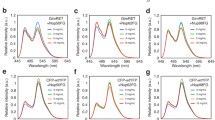Abstract
Fibrillarin is an evolutionarily-conserved and obligatory protein component of eukaryotic cell nucleoli involved in pre-rRNA processing and methylation. In vertebrates the fibrillarin molecule contains two cysteine residues (Cys99 and Cys268) whose sulfhydryl groups are able to establish intramolecular -S-S- bridges. However, the functional state of fibrillarin with reduced or oxidized thiol groups is still practically unstudied. Besides, there are no data in the literature concerning existence of the -S-S- fibrillarin form in human cells. To answer these questions, we used plasmids encoding native human fibrillarin and its mutant form devoid of cysteine residues (fibrillarinC99/268S) fused with EGFP for temporary transfection of HeLa cells. The mobile fraction localizing the enzymatically active protein molecules and the fluorescence half-recovery time characterizing the rate of enzymatic reactions were determined by the FRAP technique using a confocal laser scanning microscope. Measurements were carried out at 37 and 27°C. The results show that the fibrillarin pool in HeLa cells includes two protein forms, with reduced SH groups and with oxidized SH groups forming intramolecular -S-S- bridges between Cys99 and Cys268. However, the absence of Cys99 and Cys268 has no effect on intracellular localization of fibrillarin and its main dynamic parameters. The human fibrillarin form without disulfide bridges is included into the mobile protein fraction and is consistent with its functionally active state.
Similar content being viewed by others
References
Aris, J. P., and Blobel, G. (1991) Cell Biol., 88, 931–935.
Pearson, D. L., Reimonenq, R. D., and Pollard, K. M. (1999) Protein Expres. Purif., 17, 49–56.
Aittaleb, M., Visone, T., Fenley, M. O., and Li, H. (2004) J. Biol. Chem., 279, 41822–41829.
Tollervey, D. (1993) Cell, 72, 443–457.
Newton, K., Petfalski, E., Tollervey, D., and Caceres, J. F. (2003) Mol. Cell. Biol., 23, 8519–8527.
Fatica, A., Galardi, S., Altieri, F., and Bozzoni, I. (2000) RNA, 6, 88–95.
Gerbi, S. A., and Borovjagin, A. (1997) Chromosoma, 105, 401–406.
Tran, E. J., Zhang, X., and Maxwell, E. S. (2003) EMBO J., 22, 3930–3940.
Snaar, S., Wiesmeijer, K., Jochemsen, A. G., Tanke, H. J., and Dirks, R. W. (2000) J. Cell Biol., 151, 653–662.
Levitsky, S. A., Mukhar’yamova, K. Sh., Veiko, V. P., and Zatsepina, O. V. (2004) Mol. Biol. (Moscow), 38, 1–10.
Wang, H., Boisvert, D., Kim, K. K., Kim, R., and Kim, S.-H. (2000) EMBO J., 19, 317–323.
Martin, J. L., and McMillan, F. M. (2002) Curr. Opin. Struct. Biol., 12, 783–793.
Reichow, S. L., Hamma, T., Ferre-D’Amare, A. R., and Varani, G. (2007) Nucleic Acids Res., 35, 1452–1464.
Pollard, K. M., Lee, D. K., Casiano, C. A., Bluthner, M., Johnston, M. M., and Tan, E. M. (1997) J. Immunol., 158, 3521–3528.
Takeuchi, K., Turley, S. J., Tan, E. M., and Pollard, K. M. (1995) J. Immunol., 154, 961–971.
Chen, M., Rockel, T., Steinweger, G., Hemmerich, P., Risch, J., and von Mikecz, A. (2002) Mol. Biol. Cell, 13, 3576–3587.
Chen, M., and von Mikecz, A. (2005) Ann. N. Y. Acad. Sci., 1051, 382–389.
Torchinsky, Yu. M. (1971) Sulfhydryl and Disulfide Groups in Proteins [in Russian], Nauka, Moscow.
Jocelyn, P. C. (1972) Biochemistry of the SH Group, Academic Press, London-New York.
Friedman, M. (1973) The Chemistry and Biochemistry of the Sulfhydryl Group in Amino Acids, Peptides, and Proteins, Oxford, New York.
Gurskaya, N. G., Verkhusha, V. V., Shcheglov, A. S., Staroverov, D. B., Chepurnykh, T. V., Fradkov, A. F., Lukyanov, S., and Lukyanov, K. A. (2006) Nat. Biotechnol., 24, 461–465.
Trinkle-Mulcahy, L., and Lamond, A. I. (2007) Science, 318, 1402–1407.
Houtsmuller, A. B. (2005) Adv. Biochem. Eng. Biotechnol., 95, 177–199.
Van Royen, M. E., Farla, P., Mattern, K. A., Geverts, B., Trapman, J., and Houtsmuller, A. B. (2009) in The Nucleus (Hancock, R., ed.) Humana Press, New York, pp. 363–385.
Phair, R. D., and Misteli, T. (2000) Nature, 404, 604–609.
Fradkov, A. F., Verkhusha, V. V., Staroverov, D. B., Bulina, M. E., Yanushevich, Y. G., Martynov, V. I., Lukyanov, S., and Lukyanov, K. A. (2002) Biochem. J., 368, 17–21.
Levitsky, S. A., Mukhar’yamova, K. Sh., Zatsepina, O. V., and Veiko, V. P. (2004) Biotekhnologiya, 6, 19–26.
Hoogstraten, D., Nigg, A. L., Heath, H., Mullenders, L. H., van Driel, R., Hoeijmakers, J. H., Vermeulen, W., and Houtsmuller, A. B. (2002) Mol. Cell., 10, 1163–1174.
Dobrucki, J. W., Feret, D., and Noatynska, A. (2007) Biophys. J., 93, 1778–1786.
Mukhar’yamova, K. Sh., and Zatsepina, O. V. (2001) Tsitologiya, 43, 792–795.
Ershov, Yu. A., and Pletneva, T. V. (1989) Mechanisms of Toxic Effects of Inorganic Compounds [in Russian], Meditsina, Moscow.
Kutsenko, S. A. (2004) Bases of Toxicology [in Russian], Foliant Publishing House, St. Petersburg.
Zalups, R. K., and Ahmad, S. (2004) J. Am. Soc. Nephrol., 15, 2023–2031.
Verheggen, C., le Panse, S., Almouzni, G., and Hernandez-Verdun, D. (2001) Exp. Cell Res., 269, 23–34.
Ochs, R. L., and Smetana, K. (1991) Exp. Cell Res., 197, 183–190.
Author information
Authors and Affiliations
Corresponding author
Additional information
Original Russian Text © V. V. Barygina, V. P. Veiko, O. V. Zatsepina, 2010, published in Biokhimiya, 2010, Vol. 75, No. 8, pp. 1079–1090.
Originally published in Biochemistry (Moscow) On-Line Papers in Press, as Manuscript BM10-028, June 27, 2010.
Rights and permissions
About this article
Cite this article
Barygina, V.V., Veiko, V.P. & Zatsepin, O.V. Analysis of nucleolar protein fibrillarin mobility and functional state in living HeLa cells. Biochemistry Moscow 75, 979–988 (2010). https://doi.org/10.1134/S0006297910080055
Received:
Revised:
Published:
Issue Date:
DOI: https://doi.org/10.1134/S0006297910080055



